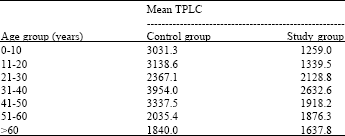Research Article
Total Peripheral Lymphocyte Count in Malignant Tumors: An Index of Prognostication
Departments of Pathology, Surgery and Radiotherapy, Jawaharlal Nehru Medical College, AMU., Aligarh, India
Kafil Akhtar
Departments of Pathology, Surgery and Radiotherapy, Jawaharlal Nehru Medical College, AMU., Aligarh, India
A.K. Verma
Departments of Pathology, Surgery and Radiotherapy, Jawaharlal Nehru Medical College, AMU., Aligarh, India
Amjad Zia Mallik
Departments of Pathology, Surgery and Radiotherapy, Jawaharlal Nehru Medical College, AMU., Aligarh, India
Shahid Ali Siddiqui
Departments of Pathology, Surgery and Radiotherapy, Jawaharlal Nehru Medical College, AMU., Aligarh, India











